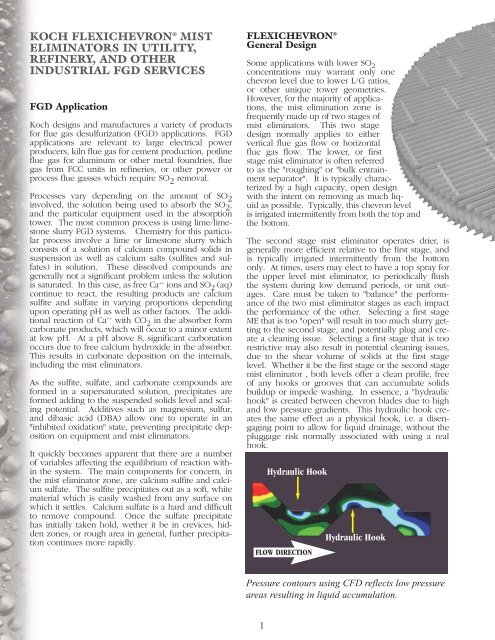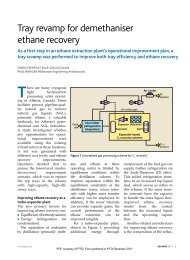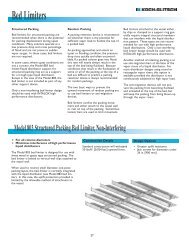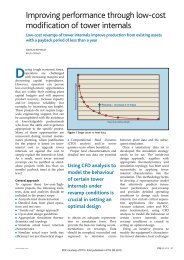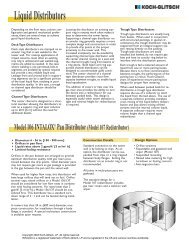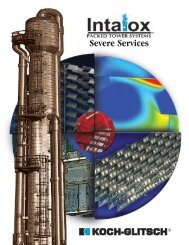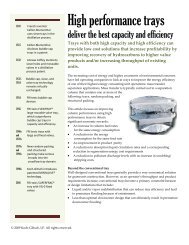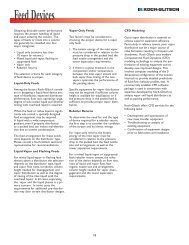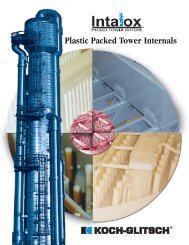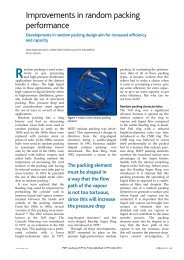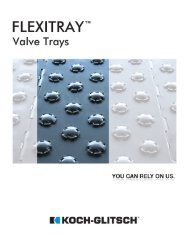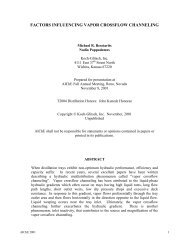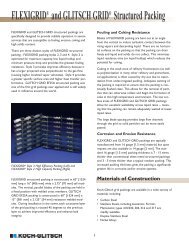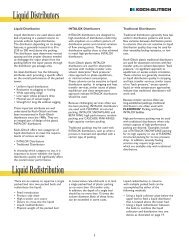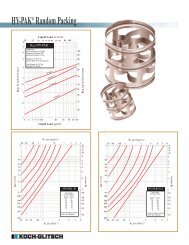FLEXICHEVRON® Mist Eliminators for Flue Gas ... - Koch-Glitsch
FLEXICHEVRON® Mist Eliminators for Flue Gas ... - Koch-Glitsch
FLEXICHEVRON® Mist Eliminators for Flue Gas ... - Koch-Glitsch
Create successful ePaper yourself
Turn your PDF publications into a flip-book with our unique Google optimized e-Paper software.
KOCH FLEXICHEVRON ® MIST<br />
ELIMINATORS IN UTILITY,<br />
REFINERY, AND OTHER<br />
INDUSTRIAL FGD SERVICES<br />
FGD Application<br />
<strong>Koch</strong> designs and manufactures a variety of products<br />
<strong>for</strong> flue gas desulfurization (FGD) applications. FGD<br />
applications are relevant to large electrical power<br />
producers, kiln flue gas <strong>for</strong> cement production, potline<br />
flue gas <strong>for</strong> aluminum or other metal foundries, flue<br />
gas from FCC units in refineries, or other power or<br />
process flue gasses which require SO 2 removal.<br />
Processes vary depending on the amount of SO 2<br />
involved, the solution being used to absorb the SO 2 ,<br />
and the particular equipment used in the absorption<br />
tower. The most common process is using lime/limestone<br />
slurry FGD systems. Chemistry <strong>for</strong> this particular<br />
process involve a lime or limestone slurry which<br />
consists of a solution of calcium compound solids in<br />
suspension as well as calcium salts (sulfites and sulfates)<br />
in solution. These dissolved compounds are<br />
generally not a significant problem unless the solution<br />
is saturated. In this case, as free Ca ++ ions and SO 2 (aq)<br />
continue to react, the resulting products are calcium<br />
sulfite and sulfate in varying proportions depending<br />
upon operating pH as well as other factors. The additional<br />
reaction of Ca ++ with CO 2 in the absorber <strong>for</strong>m<br />
carbonate products, which will occur to a minor extent<br />
at low pH. At a pH above 8, significant carbonation<br />
occurs due to free calcium hydroxide in the absorber.<br />
This results in carbonate deposition on the internals,<br />
including the mist eliminators.<br />
As the sulfite, sulfate, and carbonate compounds are<br />
<strong>for</strong>med in a supersaturated solution, precipitates are<br />
<strong>for</strong>med adding to the suspended solids level and scaling<br />
potential. Additives such as magnesium, sulfur,<br />
and dibasic acid (DBA) allow one to operate in an<br />
"inhibited oxidation" state, preventing precipitate deposition<br />
on equipment and mist eliminators.<br />
It quickly becomes apparent that there are a number<br />
of variables affecting the equilibrium of reaction within<br />
the system. The main components <strong>for</strong> concern, in<br />
the mist eliminator zone, are calcium sulfite and calcium<br />
sulfate. The sulfite precipitates out as a soft, white<br />
material which is easily washed from any surface on<br />
which it settles. Calcium sulfate is a hard and difficult<br />
to remove compound. Once the sulfate precipitate<br />
has initially taken hold, wether it be in crevices, hidden<br />
zones, or rough area in general, further precipitation<br />
continues more rapidly.<br />
FLEXICHEVRON ®<br />
General Design<br />
Some applications with lower SO 2<br />
concentrations may warrant only one<br />
chevron level due to lower L/G ratios,<br />
or other unique tower geometries.<br />
However, <strong>for</strong> the majority of applications,<br />
the mist elimination zone is<br />
frequently made up of two stages of<br />
mist eliminators. This two stage<br />
design normally applies to either<br />
vertical flue gas flow or horizontal<br />
flue gas flow. The lower, or first<br />
stage mist eliminator is often referred<br />
to as the "roughing" or "bulk entrainment<br />
separator". It is typically characterized<br />
by a high capacity, open design<br />
with the intent on removing as much liquid<br />
as possible. Typically, this chevron level<br />
is irrigated intermittently from both the top and<br />
the bottom.<br />
The second stage mist eliminator operates drier, is<br />
generally more efficient relative to the first stage, and<br />
is typically irrigated intermittently from the bottom<br />
only. At times, users may elect to have a top spray <strong>for</strong><br />
the upper level mist eliminator, to periodically flush<br />
the system during low demand periods, or unit outages.<br />
Care must be taken to "balance" the per<strong>for</strong>mance<br />
of the two mist eliminator stages as each impact<br />
the per<strong>for</strong>mance of the other. Selecting a first stage<br />
ME that is too "open" will result in too much slurry getting<br />
to the second stage, and potentially plug and create<br />
a cleaning issue. Selecting a first stage that is too<br />
restrictive may also result in potential cleaning issues,<br />
due to the shear volume of solids at the first stage<br />
level. Whether it be the first stage or the second stage<br />
mist eliminator , both levels offer a clean profile, free<br />
of any hooks or grooves that can accumulate solids<br />
buildup or impede washing. In essence, a "hydraulic<br />
hook" is created between chevron blades due to high<br />
and low pressure gradients. This hydraulic hook creates<br />
the same effect as a physical hook, i.e. a disengaging<br />
point to allow <strong>for</strong> liquid drainage, without the<br />
pluggage risk normally associated with using a real<br />
hook.<br />
Hydraulic Hook<br />
FLOW DIRECTION<br />
Hydraulic Hook<br />
Pressure contours using CFD reflects low pressure<br />
areas resulting in liquid accumulation.<br />
1


